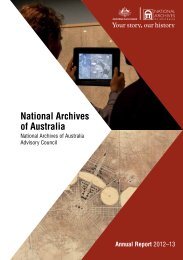National Archives of Australia - Annual reports
National Archives of Australia - Annual reports
National Archives of Australia - Annual reports
You also want an ePaper? Increase the reach of your titles
YUMPU automatically turns print PDFs into web optimized ePapers that Google loves.
Note 1: Summary <strong>of</strong> Significant Accounting Policies1.1 Objectives <strong>of</strong> the <strong>National</strong> <strong>Archives</strong> <strong>of</strong> <strong>Australia</strong>The <strong>National</strong> <strong>Archives</strong> <strong>of</strong> <strong>Australia</strong> (the <strong>Archives</strong>) is an <strong>Australia</strong>n Government controlled entity. Theobjective <strong>of</strong> the <strong>Archives</strong> is to maintain the records created by <strong>Australia</strong>n Government agencies that form thearchival resources <strong>of</strong> the Commonwealth.The <strong>Archives</strong> is structured to meet two outcomes:Outcome 1: Authentic, reliable and useable Commonwealth records through the provision <strong>of</strong> informationmanagement products and services to <strong>Australia</strong>n Government agencies.Outcome 2: Greater understanding <strong>of</strong> our heritage and democracy through preserving, describing andproviding access to the national archival collection.The continued existence <strong>of</strong> the <strong>Archives</strong> in its present form and with its present programs is dependent onGovernment policy and on continuing funding by Parliament for the <strong>Archives</strong>' administration and programs.Activities contributing toward these outcomes are classified as either departmental or administered.Departmental activities involve the use <strong>of</strong> assets, liabilities, income and expenses controlled or incurred bythe <strong>Archives</strong> in its own right. Administered activities involve the management and oversight by the <strong>Archives</strong>,on behalf <strong>of</strong> Government, <strong>of</strong> items controlled or incurred by the Government.The <strong>Archives</strong> does not generally conduct administered activities. However, in 2010-11, the <strong>Archives</strong> receiveda payment <strong>of</strong> penalty interest, on behalf <strong>of</strong> Government, from the <strong>Australia</strong>n Taxation Office, which wasclassified as administered.1.2 Basis <strong>of</strong> Preparation <strong>of</strong> the Financial StatementsThe financial statements are general purpose financial statements and are required by section 49 <strong>of</strong> theFinancial Management and Accountability Act 1997.The financial statements have been prepared in accordance with:a) Finance Minister’s Orders (or FMOs) for reporting periods ending on or after 1 July 2010; andb) <strong>Australia</strong>n Accounting Standards and Interpretations issued by the <strong>Australia</strong>n Accounting StandardsBoard (AASB) that apply for the reporting period.The financial statements have been prepared on an accrual basis and in accordance with the historical costconvention, except for certain assets and liabilities at fair value. Except where stated, no allowance is madefor the effect <strong>of</strong> changing prices on the results or the financial position.The financial statements are presented in <strong>Australia</strong>n dollars and values are rounded to the nearest thousanddollars unless otherwise specified.Unless an alternative treatment is specifically required by an accounting standard or the FMOs, assets andliabilities are recognised in the balance sheet when and only when it is probable that future economic benefitswill flow to the entity or a future sacrifice <strong>of</strong> economic benefits will be required and the amounts <strong>of</strong> the assetsor liabilities can be reliably measured. However, assets and liabilities arising under executory contracts arenot recognised unless required by an accounting standard. Liabilities and assets that are unrecognised arereported in the schedule <strong>of</strong> commitments or the schedule <strong>of</strong> contingencies.Unless alternative treatment is specifically required by an accounting standard, income and expenses arerecognised in the statement <strong>of</strong> comprehensive income when and only when the flow, consumption or loss <strong>of</strong>economic benefits has occurred and can be reliably measured.Financial statements 65



